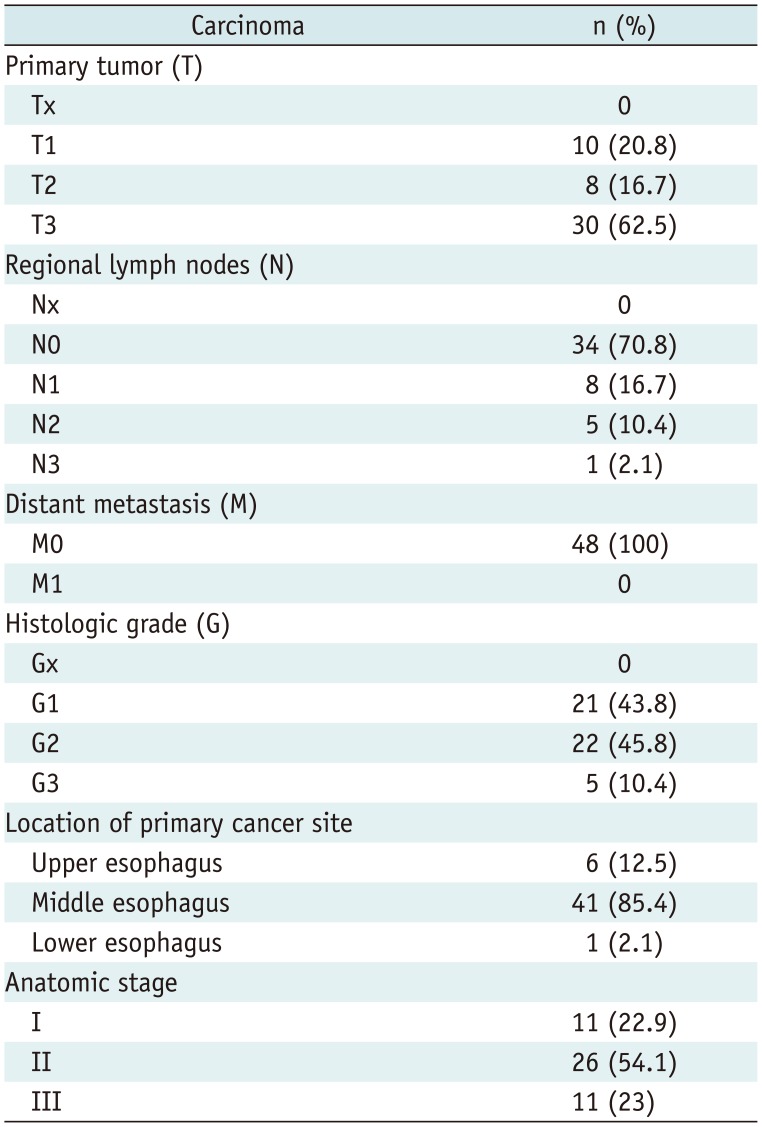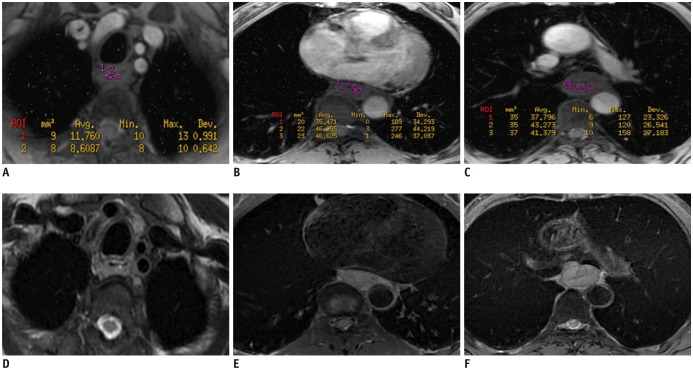1. Enzinger PC, Mayer RJ. Esophageal cancer. N Engl J Med. 2003; 349:2241–2252. PMID:
14657432.

2. van Hagen P, Hulshof MC, van Lanschot JJ, Steyerberg EW, van Berge Henegouwen MI, Wijnhoven BP, et al. Preoperative chemoradiotherapy for esophageal or junctional cancer. N Engl J Med. 2012; 366:2074–2084. PMID:
22646630.

3. Cao LY, Yin Y, Li H, Jiang Y, Zhang HF. Expression and clinical significance of S100A2 and p63 in esophageal carcinoma. World J Gastroenterol. 2009; 15:4183–4188. PMID:
19725154.

4. Jemal A, Bray F, Center MM, Ferlay J, Ward E, Forman D. Global cancer statistics. CA Cancer J Clin. 2011; 61:69–90. PMID:
21296855.

5. Fitzgerald RC. Review article: Barrett's oesophagus and associated adenocarcinoma--a UK perspective. Aliment Pharmacol Ther. 2004; 20(Suppl 8):45–49.
6. Nomura M, Oze I, Kodaira T, Abe T, Komori A, Narita Y, et al. Comparison between surgery and definitive chemoradiotherapy for patients with resectable esophageal squamous cell carcinoma: a propensity score analysis. Int J Clin Oncol. 2016; 21:890–898. PMID:
26980212.

7. Kitagawa Y. [Therapeutic strategies for advanced respectable esophageal cancer]. Nihon Geka Gakkai Zasshi. 2008; 109:333–337. PMID:
19068714.
8. Fokas E, Rödel C. Definitive, preoperative, and palliative radiation therapy of esophageal cancer. Viszeralmedizin. 2015; 31:347–353. PMID:
26989391.

9. Ripley RT, Sarkaria IS, Grosser R, Sima CS, Bains MS, Jones DR, et al. Pretreatment dysphagia in esophageal cancer patients may eliminate the need for staging by endoscopic ultrasonography. Ann Thorac Surg. 2016; 101:226–230. PMID:
26603024.

10. Puli SR, Reddy JB, Bechtold ML, Antillon D, Ibdah JA, Antillon MR. Staging accuracy of esophageal cancer by endoscopic ultrasound: a meta-analysis and systematic review. World J Gastroenterol. 2008; 14:1479–1490. PMID:
18330935.

11. Rice TW. Clinical staging of esophageal carcinoma. CT, EUS, and PET. Chest Surg Clin N Am. 2000; 10:471–485. PMID:
10967751.
12. Riddell AM, Allum WH, Thompson JN, Wotherspoon AC, Richardson C, Brown G. The appearances of oesophageal carcinoma demonstrated on high-resolution, T2-weighted MRI, with histopathological correlation. Eur Radiol. 2007; 17:391–399. PMID:
16941094.

13. Riddell AM, Hillier J, Brown G, King DM, Wotherspoon AC, Thompson JN, et al. Potential of surface-coil MRI for staging of esophageal cancer. AJR Am J Roentgenol. 2006; 187:1280–1287. PMID:
17056917.

14. Tang MY, Chen TW, Zhang XM, Huang XH. GRE T2
*-weighted MRI: principles and clinical applications. Biomed Res Int. 2014; 2014:312142. PMID:
24987676.
15. Li Y, Song QW, Sun MY, Wang HQ, Wang S, Wei Q, et al. Use of enhanced T2 star-weighted angiography (ESWAN) and R2
* values to distinguish ovarian cysts due to endometriosis from other causes. Abdom Imaging. 2015; 40:1733–1741. PMID:
25504223.
16. Howe FA, Robinson SP, Rodrigues LM, Stubbs M, Griffiths JR. Issues in GRE & SE magnetic resonance imaging to probe tumor oxygenation. Adv Exp Med Biol. 2003; 530:441–448. PMID:
14562739.
17. Chavhan GB, Babyn PS, Thomas B, Shroff MM, Haacke EM. Principles, techniques, and applications of T2
*-based MR imaging and its special applications. Radiographics. 2009; 29:1433–1449. PMID:
19755604.
18. Rodrigues LM, Howe FA, Griffiths JR, Robinson SP. Tumor R2
* is a prognostic indicator of acute radiotherapeutic response in rodent tumors. J Magn Reson Imaging. 2004; 19:482–488. PMID:
15065173.
19. Zhang LJ, Zhang Z, Xu J, Jin N, Luo S, Larson AC, et al. Carbogen gas-challenge blood oxygen level-dependent magnetic resonance imaging in hepatocellular carcinoma: initial results. Oncol Lett. 2015; 10:2009–2014. PMID:
26622788.

20. Li D, Wang X, Wang S, Cheng J. Correlation between BOLD-MRI and HIF expression level in renal carcinoma. Int J Clin Exp Pathol. 2015; 8:13759–13763. PMID:
26722605.
21. Rakow-Penner R, Daniel B, Glover GH. Detecting blood oxygen level-dependent (BOLD) contrast in the breast. J Magn Reson Imaging. 2010; 32:120–129. PMID:
20578018.

22. Alonzi R, Padhani AR, Maxwell RJ, Taylor NJ, Stirling JJ, Wilson JI, et al. Carbogen breathing increases prostate cancer oxygenation: a translational MRI study in murine xenografts and humans. Br J Cancer. 2009; 100:644–648. PMID:
19190629.

23. Pennathur A, Gibson MK, Jobe BA, Luketich JD. Oesophageal carcinoma. Lancet. 2013; 381:400–412. PMID:
23374478.

24. Li Z, Rice TW. Diagnosis and staging of cancer of the esophagus and esophagogastric junction. Surg Clin North Am. 2012; 92:1105–1126. PMID:
23026272.

25. Bland JM, Altman DG. Statistical methods for assessing agreement between two methods of clinical measurement. Lancet. 1986; 1:307–310. PMID:
2868172.

26. Quint LE, Bogot NR. Staging esophageal cancer. Cancer Imaging. 2008; 8:S33–S42. PMID:
18852079.

27. Butler JM, Kobayashi H, Rafii S. Instructive role of the vascular niche in promoting tumour growth and tissue repair by angiocrine factors. Nat Rev Cancer. 2010; 10:138–146. PMID:
20094048.

28. Hanahan D, Weinberg RA. Hallmarks of cancer: the next generation. Cell. 2011; 144:646–674. PMID:
21376230.

29. Gholamin M, Moaven O, Memar B, Farshchian M, Naseh H, Malekzadeh R, et al. Overexpression and interactions of interleukin-10, transforming growth factor beta, and vascular endothelial growth factor in esophageal squamous cell carcinoma. World J Surg. 2009; 33:1439–1445. PMID:
19440651.
30. Wang W, Sun QK, He YF, Ma DC, Xie MR, Ji CS, et al. Overexpression of periostin is significantly correlated to the tumor angiogenesis and poor prognosis in patients with esophageal squamous cell carcinoma. Int J Clin Exp Pathol. 2014; 7:593–601. PMID:
24551279.
31. Koga T, Shibahara K, Kabashima A, Sumiyoshi Y, Kimura Y, Takahashi I, et al. Overexpression of cyclooxygenase-2 and tumor angiogenesis in human gastric cancer. Hepatogastroenterology. 2004; 51:1626–1630. PMID:
15532792.
32. Kumagai Y, Sobajima J, Higashi M, Ishiguro T, Fukuchi M, Ishibashi K, et al. Coexpression of COX-2 and iNOS in angiogenesis of superficial esophageal squamous cell carcinoma. Int Surg. 2015; 100:733–743. PMID:
25875558.

33. Pedersen M, Dissing TH, Mørkenborg J, Stødkilde-Jørgensen H, Hansen LH, Pedersen LB, et al. Validation of quantitative BOLD MRI measurements in kidney: application to unilateral ureteral obstruction. Kidney Int. 2005; 67:2305–2312. PMID:
15882272.

34. Van Meir E. Hypoxia-mediated selection of cells with diminished apoptotic potential to solid tumours. Neurosurgery. 1996; 39:878–879. PMID:
8880787.
35. He Q, Xu RZ, Shkarin P, Pizzorno G, Lee-French CH, Rothman DL, et al. Magnetic resonance spectroscopic imaging of tumor metabolic markers for cancer diagnosis, metabolic phenotyping, and characterization of tumor microenvironment. Dis Markers. 2003-2004; 19:69–94.

36. Arakelyan L, Vainstein V, Agur Z. A computer algorithm describing the process of vessel formation and maturation, and its use for predicting the effects of anti-angiogenic and anti-maturation therapy on vascular tumor growth. Angiogenesis. 2002; 5:203–214. PMID:
12831061.
37. Boucher Y, Jain RK. Microvascular pressure is the principal driving force for interstitial hypertension in solid tumors: implications for vascular collapse. Cancer Res. 1992; 52:5110–5114. PMID:
1516068.
38. Horsman MR, Overgaard J. The impact of hypoxia and its modification of the outcome of radiotherapy. J Radiat Res. 2016; 57(Suppl 1):i90–i98. PMID:
26983987.









 PDF
PDF ePub
ePub Citation
Citation Print
Print


 XML Download
XML Download